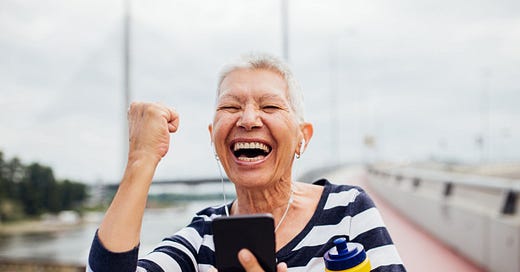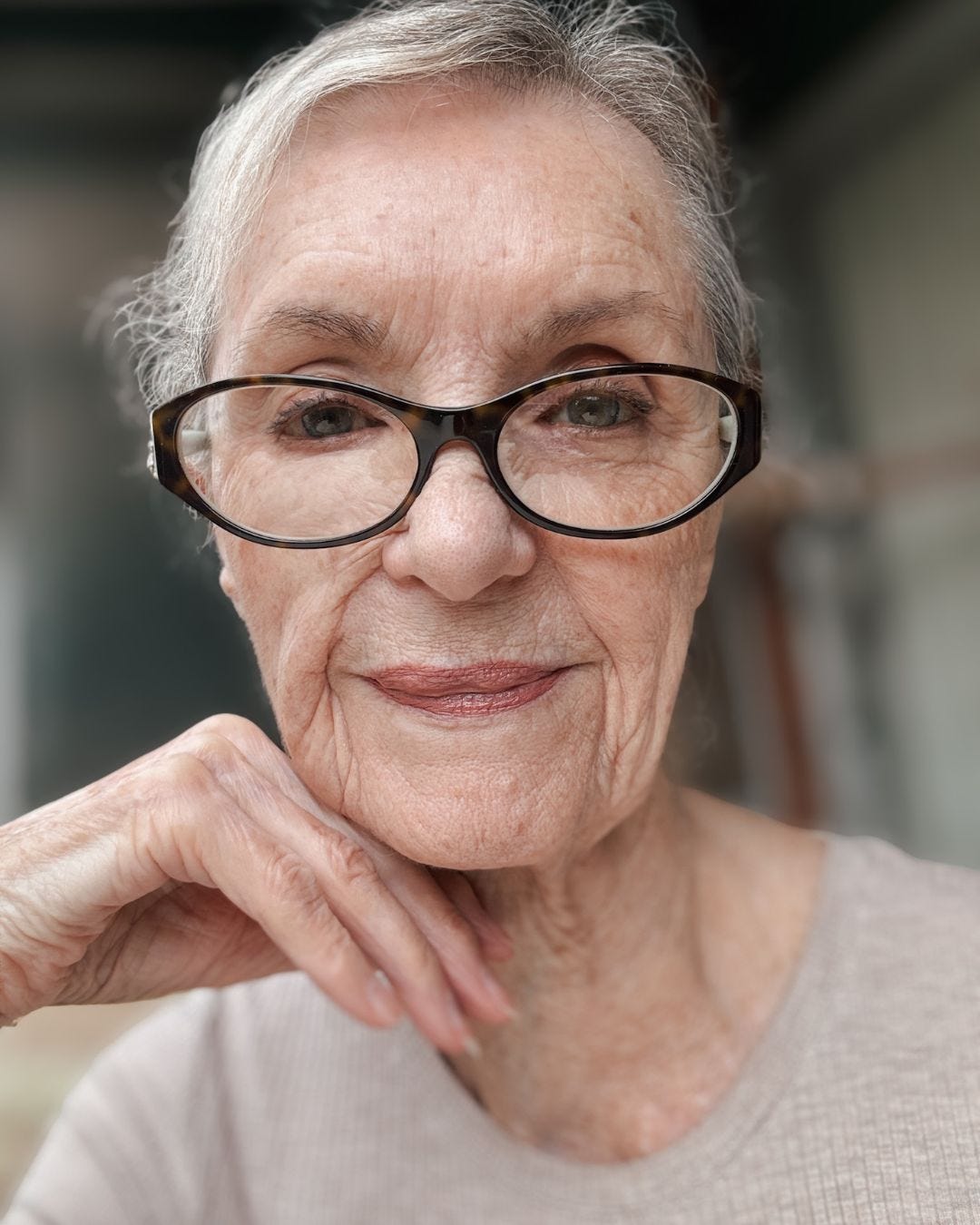Hi, I’m so happy you dropped by!
I’ve been exploring our future possibilities as women who are sixty and above and on the self-publishing path. Let’s start with some stats.
The Sexism Shift
United States
Thanks to a 2023 study by Joel Waldfogel, an economist at the University of Minnesota’s Carlson School of Management, we now know just how far female authors have come since the 1970s. Waldfogel’s research data revealed that women’s share of the published titles increased from around 20% in the 1970s to over 50% by 2020.
Women now publish more than 50% of books annually in the USA.
Female authors sell more books than the average male author.
As of 2020, there were 103,693 female authors in the US.
American women are more likely to read books than American men, especially fiction.
The most popular channels for promoting books are run by women - think Oprah’s Book Club and Reese’s Book Club.
Australia
It’s the same story in Australia, where I live.
According to Claire Keenan, women comprise 65% of Australian writers, 77% of employees in Australian publishing, and 61% of '” frequent readers”.
A whopping 22,500 new book titles are published in Australia every year.
In 2020, more than half the books reviewed in Australian publications were by female authors, a space Keenan says is usually occupied by male authors.
Two-fifths of authors (42.4%) describe themselves as emerging or developing, and nearly two-fifths (39.4%) identify as an established author.
UK
Statistics curated by Pick Up Your Pen show a rather bleak picture.
There are 78,200 writers and translators in the UK, of whom 47,000 are female.
Between 2006 and 2022, professional writers’ earnings fell, on average, by 60%.
In 2018, writers earned 80% of their earnings from publishers and 9% from self-publishing.
By 2022, only 33% of writers reported having an agent, and only 60% reported receiving an advance. Advances are becoming less common, and their value has substantially decreased.
The median royalty rate is 10% for a hardback and 8% for a paperback.
The Ageism Shift
The good news is that it looks like there is an emerging shift that challenges the image of women 60s-plus as:
Suffering from frailty and inevitable decline in mental and physical capabilities.
Someone who is forgetful and lacking in computer literacy and technological know-how.
Instead, Amelia Hill, in her 2023 article, ‘Things are definitely opening up: the rise of older female writers’, states that:
Unpublished authors in their 60s, 70s, and 80s-(that’s us!) are now at a premium in the book world, adding that ‘radical, edgy women aged into their 80s’ are particularly sought-after.
Hmm, what do I have to do to be radical and edgy?
Anne Green wondered the same thing, contemplating adopting a ‘funkier, retro look, sort of aged hippie, flowing garments to go with the flowing flesh!’ I might pass on that one!
Previous Winners
According to Green, the previous winners in the publishing world have been:
Edgy (that word again!) young breakout novelists who are possibly easier to market and promote. She thinks agents and publishers may question whether older writers are able to sell themselves on social media, amongst other things.
Liz Evans, in The Conversation, states she’s over ‘Sad Bad Girl novels and sensationalised trauma’. In these novels, the protagonist is typically in her late 20s or early 30s, and, according to Evans, she is ‘self-obsessed, self-serving and self-destructive’, and Evans has had enough of her. Ouch!
Evans is hungry for complex stories about women.
We can do that!
Other Winners
These have been female authors in their forties—then a sliding scale back towards 30 and forward to the late 50s.
Becoming A Hot Item
Sea Change
Green quotes Cherry Potts, founder of Arachne Press, as saying:
“There has been a sea change in publishers’ understanding and acceptance of older women’s experience and their voices, which are no longer dismissed as safe or cosy.”
Green also mentions Becca Levy, who cites other research that shows ‘authors’ use of language increases with age and older writers demonstrate a more meaningful engagement with emotional meaning, empathy and reflection.’
In Mary Carroll Moore’s article ‘Good News for Older Women Writers: Your Age Is a Bonus!’ prior to the good news, she shares personal experiences of ageism.
She reports that before she signed with her agent, she was told that ‘trying to get another agent after sixty was iffy.’
Appearance
Then there’s the issue of how 60s-plus women look, especially when it comes to that publicity headshot!
Post-pandemic, Moore decided not to colour her hair anymore and then worried about how her grey hair would make her look in her author headshot. She says it’s a ‘subject on all our minds’, following conversations with her colleagues.
She describes it as the ‘visibility disadvantage in the publishing world today.’ She asks, ‘How do we want to be seen? As younger? As ourselves, right now?’
I’m going with ‘as myself, right now.’
Moore says the question remains, ‘If you don’t try to look thirty, or even fifty, will you be able to (1) attract an agent, (2) get published, and (3) get read?
She was, therefore, delighted to read Hill’s article mentioned above, in which women in their 60s, 70s, and 80s are regarded as a hot item with publishers.
Hill’s article mentioned many debut authors, but Moore picked out Anne Fodorova as an example. Fodorova published her debut novel in 2022 at the age of 77. Initially, she was advised that she’d need ‘40,000 followers on social media to get a book deal.’ That was definitely not the case.
Moore is going to keep her grey hair colour but is getting her hair styled before her photo shoot!
It’s The Demographic
However, Debbie Taylor, in her post Older Women Writers-In Demand or Not? believes:
Publishers are taking on the books of older authors simply because they are following the money.
She quotes Lisa Highton, who states, ‘The vast majority of books are bought by women aged 45 and above. They’re a hugely important demographic and increasingly want to see themselves represented in books.’
In an article in The Guardian in 2021, Anne Youngson related how when she was sixty-nine:
Her agent told her a publisher had made an offer on her first novel. She was worried that they’d want to meet her, and then, when they discovered how old she was, “their whole attitude to whether they wanted me would change.”
She thought that when they met her, they’d think, “Oh God, how will we promote this?”
A major prize and two more novels later, at 73, Youngson is now writing her third novel.
Back To Ageism
Internalised Ageism
Taking a different perspective, in a poignant article in The Conversation, Homesick for Ourselves, Carol Lefevre writes of the nostalgia associated with old age:
Homesickness can be cured by returning home. But there is no possibility of returning to our youth. As Lefevre points out, ‘it’s irrecoverable.’
This, Lefevre says, ‘is an internalised ageism: innate, or else massaged into us by the culture we spring from.’
She suggests a sense of regret resonates with a feeling in old age of having ‘lost the younger self or of carrying traces, deeply buried, of other lives one might have lived.’
The Impact of Ageism
In 2020, an article published in the International Journal of Environmental Research and Public Health, which included data from 57 countries, stated that:
‘Evidence shows that ageism negatively impacts the health of older adults.’
The study also found a significant association between ‘higher levels of education and lower levels of ageism.’
Furthermore, holding ageist attitudes at an individual level ‘can decrease health and functioning.’
This finding reflected a longitudinal research study from the USA, which found that ‘older people who hold negative attitudes towards ageing live on average 7.5 years less than people with positive attitudes to ageing.’
Lastly, the study found that males held higher ageist attitudes at an individual level. Consistent with other studies, this study found that ‘men, across all age groups, are more ageist towards older adults than women.’ On the other hand, women identify more with their age ‘and view older adults as contributing more to the economy.’
Clearly, ageism and sexism are inextricably linked. I still remember reading in a newspaper years ago that a leading male fashion designer had expressed the disappointment he felt when following a fashionable woman with long blond hair only to discover when she turned around that she was old. The memory of the negative impact this had on me is still with me forty-odd years later.
There are several stories in Lefevre’s article about the cruel things men say to women about their signs of ageing.
Age Affirming
Lefevre suggests that we should de-stigmatise the word ‘old’, reclaiming it from ‘the pejorative territory it currently occupies.’ She suggests that:
Old people should start reclaiming their years with pride, possibly adopting the slogan “age pride”.
And when we find ourselves becoming homesick for who we once were, we might instead consider old age as a ‘kind of homecoming.’
After providing numerous examples of female authors who were publishing in their 70s through to 100 years of age, Green concludes in her article, Women Writers Of A Certain Age, by stating that:
These women who pursued their dreams regardless of age, ‘are the very definition of age-affirming.’
Despite the fact that these women did not fit the mould of ‘first-time authors’, she found it truly uplifting ‘to see these women whose faces are etched with so much character, wisdom and self-belief, being celebrated for their achievements.’
Final Thoughts
So, what should we take from the above?
I believe that self-publishing opens up far more opportunities for older writers than the traditional path, where we compete to get our books read by some twenty-something intern and end up with 10% royalties. It's far better to self-publish then, if the Gods smile on us, have a publisher approach us!
What I found particularly encouraging is the fact that readers are women 45 and above. That bodes well for us.
Furthermore, the argument that publishers and agents are ‘following the money’ is compelling. It ties in with the demographics. Money always talks.
There’s no doubt that the ‘image factor’ is something that all authors 60 and over confront when it concerns publicity and social media. I certainly deal with it myself and I will have more to say about this in future posts.
So, what are your thoughts?
Have you had experiences of ageism and/or sexism that you would care to share?
I would love to hear from you in the comments below, and I’m sure other readers would, too.
I am grateful to all of you who have taken time out to read my first written post on Substack.
Till next time
Kisane xoxo






This is a deeply affirming and useful article, thank you so much! I am published UK non-fiction author (when I was in my 40s) but in my 60s, I hope to be a debut novelist (planning to self-publish). I had never thought about the issue of author photographs... and how ageism might play into that, thank you for all the stats!
I am 82 and write The Granny who Stands on her Head (which I am and I do), which is also the title of my most recent book, with the subtitle Reflections on growing older. I love being old and write a lot about why. My next post is called ‘18 or 82 - which would you rather be?’ You can also see me stand on my head in a two minute video on my site. Do come have a look!